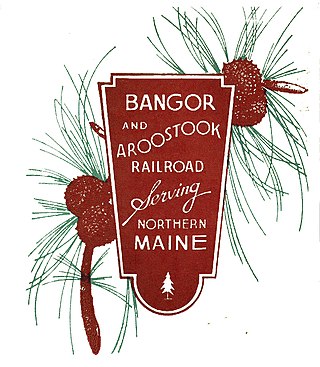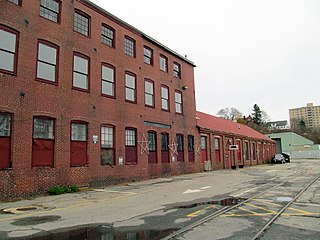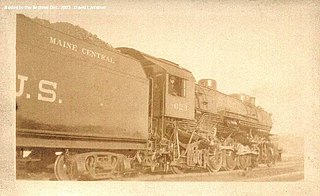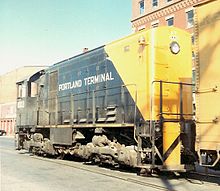
The St. Lawrence and Atlantic Railroad, known as St-Laurent et Atlantique Quebec in Canada, is a short-line railway operating between Portland, Maine, on the Atlantic Ocean, and Montreal, Quebec, on the St. Lawrence River. It crosses the Canada–US border at Norton, Vermont, and Stanhope, Quebec, and is owned by short-line operator Genesee & Wyoming.

The Bangor and Aroostook Railroad was a United States railroad company that brought rail service to Aroostook County in northern Maine. Brightly-painted BAR boxcars attracted national attention in the 1950s. First-generation diesel locomotives operated on BAR until they were museum pieces. The economic downturn of the 1980s, coupled with the departure of heavy industry from northern Maine, forced the railroad to seek a buyer and end operations in 2003. It was succeeded by the Montreal, Maine and Atlantic Railway.

The Presumpscot River is a 25.8-mile-long (41.5 km) river located in Cumberland County, Maine, United States. It is the main outlet of Sebago Lake. The river provided an early transportation corridor with reliable water power for industrial development of the city of Westbrook and the village of South Windham.

The railroad history of Portland, Maine, began in 1842 with the arrival of the Portland, Saco & Portsmouth Railway (PS&P). Most of the rail activity in Portland revolved around agricultural goods bound for export and import freight from Europe. Yet Maine's largest city also enjoyed 125 years of continuous passenger rail service, from 1842 until 1967, and Amtrak began serving the city in 2001. For most of Portland's history, passenger train schedules were designed with intercity travel rather than daily commuting in mind; passenger activities were mostly confined to intercity travel from Portland to Boston, Montreal, Nova Scotia, and points west.

The Portland Company was established 10 November 1846 by John A. Poor and Norris Locomotive Works engineer Septimus Norris as a locomotive foundry to build railroad equipment for the adjacent Portland terminus of the Atlantic and St. Lawrence Railroad connection between Portland, Maine and Montreal. The shops opened for business in October, 1847. Its first locomotive, the Augusta, emerged from the shops in July 1848 for delivery to the Portland, Saco & Portsmouth. Over the next several decades, the Company produced in its Fore Street facilities over 600 steam locomotives as well as 160 merchant and naval vessels, railcars, construction equipment, Knox automobiles, and the like. Portland Company built the engines of the civil war side-wheel gunboats Agawam and Pontoosuc. Taking into account its other products, the Company could lay claim to being one of the leading medium-to-heavy steel manufacturers in New England. The company ceased production in 1978.

The Cumberland and Oxford Canal was opened in 1832 to connect the largest lakes of southern Maine with the seaport of Portland, Maine. The canal followed the Presumpscot River from Sebago Lake through the towns of Standish, Windham, Gorham, and Westbrook. The Canal diverged from the river at Westbrook to reach the navigable Fore River estuary and Portland Harbor. The canal required 27 locks to reach Sebago Lake at an elevation of 267 feet (81 m) above sea level. One additional lock was constructed in the Songo River to provide 5 feet (1.5 m) of additional elevation to reach Long Lake from Sebago Lake. Total navigable distance was approximately 38 miles (61 km) from Portland to Harrison at the north end of Long Lake. A proposed extension from Harrison to Bear Pond and Tom Pond in Waterford would have required three more locks on the Bear River, but they were never built.
The St. Johnsbury and Lamoille County Railroad (StJ&LC) was a railroad located in northern Vermont. It provided service to rural parts of the state for over a century, until track deterioration and flood damage made the line unusable and uneconomical to repair, which forced the line to close in 1995. Vermont is in the process of converting the roughly 96-mile route from St. Johnsbury to Swanton into a rail trail, known as the Lamoille Valley Rail Trail. Once completed it will be the longest rail trail in New England.

The Mountain Division is a railroad line that was once owned and operated by the Maine Central Railroad (MEC). It stretches from Portland, Maine on the Atlantic Ocean, through the Western Maine Mountains and White Mountains of New Hampshire, ending at St. Johnsbury, Vermont in the Northeast Kingdom. The line was abandoned in 1983 by MEC's successor, Guilford Transportation Industries (GTI). Guilford retained a stub between Portland and Westbrook. A section in New Hampshire remains in use by heritage railway Conway Scenic Railroad.
The Gull was an international passenger train service between Boston, United States, and Halifax, Canada, which operated from 1930 to 1960. Journey time was approximately 24 hours. Westbound trains left Halifax shortly after breakfast and crossed the Canada–United States border in the late evening, as eastbound trains were leaving Boston's North Station to cross the border about dawn. Travel was over the Boston and Maine Railroad from Boston to Portland, Maine, then over the Maine Central Railroad to the border between Vanceboro, Maine, and Saint Croix, New Brunswick, then over the Canadian Pacific Railway to Saint John, New Brunswick, and over the Canadian National Railway to Halifax.
The State of Maine was an overnight passenger train between New York City and Portland, Maine, that was operated jointly for more than 50 years by the Boston and Maine Railroad and the New York, New Haven and Hartford Railroad. It departed New York's Pennsylvania Station at 9:00 p.m. and arrived at 6:45 a.m. at Portland's Union Station, where connections were available on Maine Central Railroad trains to most Maine locations. It ended service in October 1960, the last direct passenger rail service between New Hampshire or Maine and New York City.
The following is a timeline of the history of the city of Portland, Maine, USA.

Maine Central Railroad Class W locomotives were intended for heavy freight service. They were of 2-8-0 wheel arrangement in the Whyte notation, or "1'D" in UIC classification. They replaced earlier class O 4-6-0 locomotives beginning in 1910. They were in turn replaced by class S 2-8-2 locomotives for the heaviest freight service beginning in 1914, but remained in use on lighter freight trains until replaced by diesel locomotives after World War II.

Maine Central Railroad Class S locomotives were intended for heavy freight service. They were of 2-8-2 wheel arrangement in the Whyte notation, or " 1'D1' " in UIC classification. They replaced earlier class W 2-8-0 locomotives beginning in 1914. They were the largest and most modern steam freight locomotives built for Maine Central; although former Boston and Maine Railroad 2-10-2s were later purchased to handle World War II freight traffic. Class S locomotives pulled freight trains over the main line between Portland and Bangor, Maine; and are best remembered for service on the Mountain Division from 1929, when the class X Mallet locomotives were scrapped, until replacement by diesel locomotives in the early 1950s.

Maine Central Railroad Class C locomotives were intended for main line passenger service. They were of 4-6-2 wheel arrangement in the Whyte notation, or " 2'C1' " in UIC classification. They replaced earlier class N 4-6-0 locomotives beginning in 1907. Class C locomotives pulled named passenger trains until replacement by diesel locomotives after World War II.
Maine Central Railroad steam switchers were designated Class K. They were of 0-6-0 wheel arrangement in the Whyte notation, or "C" in UIC classification. American Locomotive Company (ALCO) began building more powerful yard locomotives for Maine Central in 1909. Twenty locomotives numbered 161 through 180 were active in 1923, and worked in Maine's largest cities until replaced by diesels after World War II.
Maine Central Railroad Class M locomotives were originally intended for heavy freight service. They were of 2-6-0 wheel arrangement in the Whyte notation, or "1'C" in UIC classification. They were replaced by class P 2-6-0 locomotives for the heaviest freight service beginning in 1896, and spent their final years as yard switchers. The oldest of the class surviving past United States Railroad Administration operation were Portland Company builders numbers 606 and 607 built in 1890. Eleven built by Schenectady Locomotive Works in 1893 and 1894 also appeared in the 221-245 number sequence on Maine Central's 1923 locomotive roster. The longest surviving representatives of the class were three built by Schenectady in 1897 as Portland and Rumford Falls Railway numbers 10 through 12. These three were rebuilt with higher-pressure boilers in Maine Central's Waterville shop between 1914 and 1921 as sub-class M-5. These reboilered locomotives with 25,000 lbf (111.2 kN) tractive effort were numbered 246 through 248. Number 247 was the last survivor of the class when scrapped in 1946.
Maine Central Railroad began operating diesel locomotives in 1935, and had retired all steam locomotives by 1954. That time interval was a joint operating period with the Boston and Maine Railroad (B&M). This article describes diesel locomotives owned by Maine Central through the period of joint operation and later independent operation prior to Guilford Rail System control in 1981.
The Sebasticook and Moosehead Railroad was a 19th-century Maine railroad which became the 20th century Harmony Branch of the Maine Central Railroad.
Maine Central Railroad constructed a Foxcroft Branch in two stages after completing its main line from Portland to Bangor. The Dexter and Newport Railroad was completed in 1868 northward from Newport Junction on the Maine Central main line to Dexter. The completed railroad was leased by the Maine Central the following year. An extension northward from Dexter to Foxcroft on the Piscataquis River was completed in 1889 as the Dexter and Piscataquis Railroad. The branch became a major pulpwood loading point through the 1970s; but was abandoned in 1990.
Rigby Park was an American harness racing track in South Portland, Maine, that was open from 1893 to 1899. It was torn down in 1922 and replaced by the Rigby Yard, Maine's busiest rail yard.













